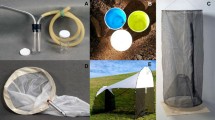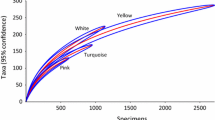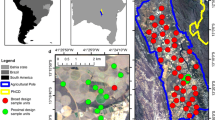Abstract
Declines in pollinator populations have made monitoring pollinators, in particular bees, increasingly important. There is general agreement among practitioners that using a mix of trap colours is important, but the empirical evidence to support this is scattered. During studies of bees in forestry cutovers, large differences were noted in capture rate among white, blue, and yellow pan traps. Pooled data from collections in cutovers and commercial cranberry fields demonstrated significant differences in the effect of trap colour, with the largest numbers captured in white traps, and the fewest in yellow, but only for the genus Bombus Latreille (Hymenoptera: Apidae). The colour preference was consistent with the spectral sensitivity of Bombus, and the visible reflectance spectra of the traps. A literature review suggested that among eusocial bees, Apis Linnaeus (Hymenoptera: Apidae) are more attracted to white traps and Bombus are more attracted to blue traps, while non-eusocial bees with a variety of social structures are more attracted to yellow. Among the non-eusocial bees, Halictidae were somewhat attracted to blue, while Andrenidae were not. This supports the common practice of using white, blue, and yellow traps when surveying bees to ensure adequate taxonomic representation.


Similar content being viewed by others
References
Entries marked with an asterisk were part of the literature review and are summarized in Supplementary Table S1
*Abrahamczyk S, Steudel B, Kessler M (2010) Sampling Hymenoptera along a precipitation gradient in tropical forests: the effectiveness of different coloured pan traps. Entomol Exp Appl 137:262–268. https://doi.org/10.1111/j.1570-7458.2010.01063.x
Bates D, Maechler M, Bolker B, Walker S (2013) lme4: Linear mixed-effects models using Eigen and S4. R package version 1.0–4. http://CRAN.R-project.org/package=lme4. Accessed 15 Feb 2017
*Campbell JW, Hanula JL (2007) Efficiency of Malaise traps and colored pan traps for collecting flower visiting insects from three forested ecosystems. J Insect Conserv 11:399–408. https://doi.org/10.1007/s10841-006-9055-4
Cane JH, Minckley RL, Kervin LJ (2000) Sampling bees (Hymenoptera: Apiformes) for pollinator community studies: pitfalls of pan-trapping. J Kans Entomol Soc 73:225–231
Cariveau DP, Williams NM, Benjamin FE, Winfree R (2013) Response diversity to land use occurs but does not consistently stabilise ecosystem services provided by native pollinators. Ecol Lett 16:903–911. https://doi.org/10.1111/ele.12126
Damman AWH (1983) An ecological subdivision of the Island of Newfoundland. In: South GR (ed) Biogeography and ecology of the Island of Newfoundland. Junk, The Hague, pp 163–206
Droege S (2015) The very handy manual: how to catch and identify bees and manage a collection. http://bio2.elmira.edu/fieldbio/handybeemanual.html. Accessed 2 Aug 2017
Dyer AG, Boyd-Gerny S, Shrestha M, Lunau K, Garcia JE, Koethe S, Wong BBM (2016) Innate colour preferences of the Australian native stingless bee Tetragonula carbonaria Sm. J Comp Physiol A 202:603–613. https://doi.org/10.1007/s00359-016-1101-4
*Geroff RK, Gibbs J, McCravy KW (2014) Assessing bee (Hymenoptera: Apoidea) diversity of an Illinois restored tallgrass prairie: methodology and conservation considerations. J Insect Conserv 18:951–964. https://doi.org/10.1007/s10841-014-9703-z
*Gollan JR, Ashcroft MB, Batley M (2011) Comparison of yellow and white pan traps in surveys of bee fauna in New South Wales, Australia (Hymenoptera: Apoidea: Anthophila). Aust J Entomol 50:174–178. https://doi.org/10.1111/j.1440-6055.2010.00797.x
*Gonçalves RB, Oliveira PS (2013) Preliminary results of bowl trapping bees (Hymenoptera, Apoidea) in a southern Brazil forest fragment. J Insect Biodivers 1:1–9
*Grundel R, Frohnapple KJ, Jean RP, Pavlovic NB (2011) Effectiveness of bowl trapping and netting for inventory of a bee community. Environ Entomol 40:374–380. https://doi.org/10.1603/EN09278
*Heneberg P, Bogusch P (2014) To enrich or not to enrich? Are there any benefits of using multiple colors of pan traps when sampling aculeate Hymenoptera? J Insect Conserv 18:1123–1136. https://doi.org/10.1007/s10841-014-9723-8
Hothorn T, Bretz F, Westfall P (2008) Simultaneous inference in general parametric models. Biom J 50:346–363
Laverty TM, Harder LD (1988) The bumble bees of eastern Canada. Can Entomol 120:965–987
LeBuhn G, Droege S, Connor E, Gemmill-Herren B, Azzu N (2016) Protocol to detect and monitor pollinator communities: guidance for practitioners. Food and Agriculture Organization of the United Nations, Rome
*Leong JM, Thorp R (1999) Colour-coded sampling: the pan trap colour preferences of oligolectic and nonoligolectic bees associated with a vernal pool plant. Ecol Entomol 24:329–335
Meades WJ, Moores L (1994) Forest site classification manual (2nd edn). A field guide to the forest types of Newfoundland. Canada, FRDA Report, 3. Newfoundland Forest Resource Development Agreement
Memmott J, Waser NM, Price MV (2004) Tolerance of pollination networks to species extinctions. Proc R Soc Lond B Biol Sci 271:2605–2611. https://doi.org/10.1098/rspb.2004.290
Michener CD (2007) The bees of the world, 2nd edn. The Johns Hopkins University Press, Baltimore
*Moreira EF, da Silva Santos RL, Penna UL, Angel-Coca C, de Oliveira FF, Viana BF (2016) Are pan traps colors complementary to sample community of potential pollinator insects? J Insect Conserv 20:583–596. https://doi.org/10.1007/s10841-016-9890-x
Packer L, Genaro JA, Sheffield CS (2007) The bee genera of eastern Canada. Can J Arthropod Identif 3:1–32. https://doi.org/10.3752/cjai.2007.03
Peitsch D, Fietz A, Hertel H, de Souza J, Ventura DF, Menzel R (1992) The spectral input systems of hymenopteran insects and their receptor-based colour vision. J Comp Physiol A 170:23–40
Potts SG, Biesmeijer JC, Kremen C, Neumann P, Schweiger O, Kunin WE (2010) Global pollinator declines: trends, impacts and drivers. Trends Ecol Evol 25:345–353
Potts SG, Imperatriz-Fonseca V, Ngo HT, Aizen MA, Biesmeijer JC, Breeze TD, Dicks LV, Garibaldi LA, Hill R, Settele J, Vanbergen AJ (2016) Safeguarding pollinators and their values to human well-being. Nature 540:220–229. https://doi.org/10.1016/j.tree.2010.01.007
Prado SG, Ngo HT, Florez JA, Collazo JA (2017) Sampling bees in tropical forests and agroecosystems: a review. J Insect Conserv. https://doi.org/10.1007/s10841-017-0018-8
R Core Team (2014) R: A language and environment for statistical computing. R Foundation for Statistical Computing, Vienna, Austria. http://www.R-project.org/. Accessed 12 May 2017
*Rodriguez-Saona CR, Byers JA, Schiffhauer D (2012) Effect of trap color and height on captures of blunt-nosed and sharp-nosed leafhoppers (Hemiptera: Cicadellidae) and non-target arthropods in cranberry bogs. Crop Prot 40:132–144. https://doi.org/10.1016/j.cropro.2012.05.005
Roulston TH, Smith SA, Brewster AL (2007) A comparison of pan trap and intensive net sampling techniques for documenting a bee (Hymenoptera: Apiformes) fauna. J Kans Entomol Soc 80:179–181
Sellars R, Hicks BJ (2015) Bee diversity and abundance in three different habitats of eastern Newfoundland. J Acad Entomol Soc 11:9–14
Sheffield CS, Kevan PG, Smith RF (2003) Bee species of Nova Scotia, Canada, with new records and notes on bionomics and floral relations (Hymenoptera: Apoidea). J Kans Entomol Soc 76:357–384
Sheffield CS, Kevan PG, Westby SM, Smith RF (2008) Diversity of cavity-nesting bees (Hymenoptera: Apoidea) within apple orchards and wild habitats in the Annapolis Valley, Nova Scotia, Canada. Can Entomol 140:235–249
Sheffield CS, Hebert PDN, Kevan PG, Packer L (2009) DNA barcoding a regional bee (Hymenoptera: Apoidea) fauna and its potential for ecological studies. Mol Ecol Resour 9:196–207. https://doi.org/10.1111/j.1755-0998.2009.02645.x
*Stephen WP, Rao S (2005) Unscented color traps for non-Apis bees (Hymenoptera: Apiformes). J Kans Entomol Soc 78:373–380
*Stephen WP, Rao S (2007) Sampling native bees in proximity to a highly competitive food resource (Hymenoptera: Apiformes). J Kans Entomol Soc 80:369–376
*Toler TR, Evans EW, Tepedino VJ (2005) Pan-trapping for bees (Hymenoptera: Apiformes) in Utah’s West Desert: the importance of color diversity. Pan-Pac Entomol 81:103–113
Trumble JT (2004) Motivating state workers with entomology. Am Entomol 50:10–11
*Tuell JK, Ascher JS, Issacs R (2009) Wild bees (Hymenoptera: Apoidea: Anthophila) of the Michigan highbush blueberry agroecosystem. Ann Entomol Soc Am 102:275–287
Vrdoljak SM, Samways MJ (2012) Optimising coloured pan traps to survey flower visiting insects. J Insect Conserv 16:345–354. https://doi.org/10.1007/s10841-011-9420-9
Westphal C, Bommarco R, Carré G, Lamborn E, Morison N, Petanidou T, Potts SG, Roberts SPM, Szentgyörgyi H, Tscheulin T, Vaissière BE, Woyciechowski M, Biesmeijer JC, Kunin WE, Settele J, Steffan-Dewenter I (2008) Measuring bee diversity in different European habitats and biogeographical regions. Ecol Monogr 78:653–671
*Wilson JS, Griswold T, Messinger OJ (2008) Sampling bee communities (Hymenoptera: Apiformes) in a desert landscape: are pan traps sufficient? J Kans Entomol Soc 81:288–300
Acknowledgements
This work was part of research projects supported by an Ignite Grant from the Research and Development Corporation of Newfoundland and Labrador, the Vice President Grenfell Campus Research Fund, and Corner Brook Pulp and Paper Limited. Dr. Robert Scott (Grenfell Campus, MUN) performed the reflectance measurements.
Author information
Authors and Affiliations
Corresponding author
Ethics declarations
Conflict of interest
The authors declare that they have no conflict of interest.
Ethical approval
All procedures performed involving animals were in accordance with the ethical standards the Animal Care Committee of Memorial University of Newfoundland.
Electronic supplementary material
Below is the link to the electronic supplementary material.
10841_2018_71_MOESM1_ESM.docx
Supplementary Table S1. Colour preferences of bees recorded in fifteen studies. Traps are some variation of pan traps unless otherwise indicated. Colour preference refers to the trap colour collecting the largest number of individuals; if there was no significant difference in collection rate between two colours, they are indicated as equal, e.g. B = W (DOCX 24 KB)
Rights and permissions
About this article
Cite this article
Sircom, J., Arul Jothi, G. & Pinksen, J. Monitoring bee populations: are eusocial bees attracted to different colours of pan trap than other bees?. J Insect Conserv 22, 433–441 (2018). https://doi.org/10.1007/s10841-018-0071-y
Received:
Accepted:
Published:
Issue Date:
DOI: https://doi.org/10.1007/s10841-018-0071-y




